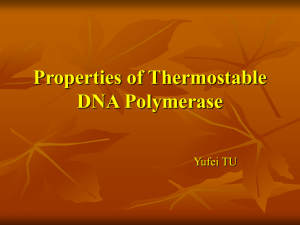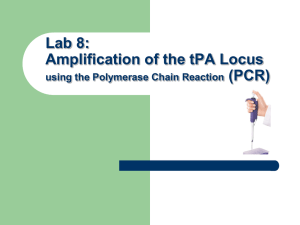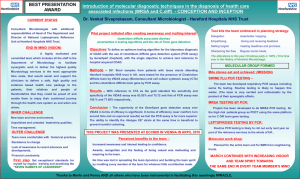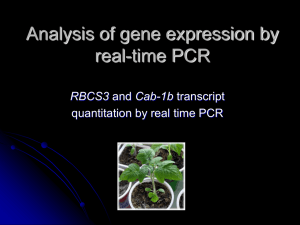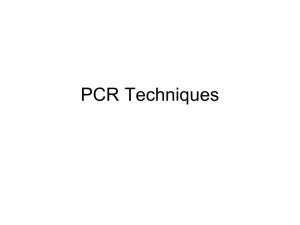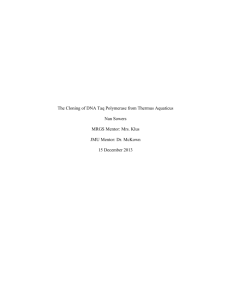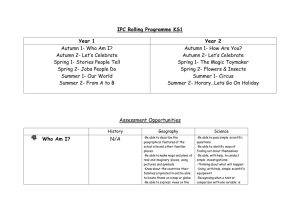Biotechnology Product Development: Taq polymerase
advertisement
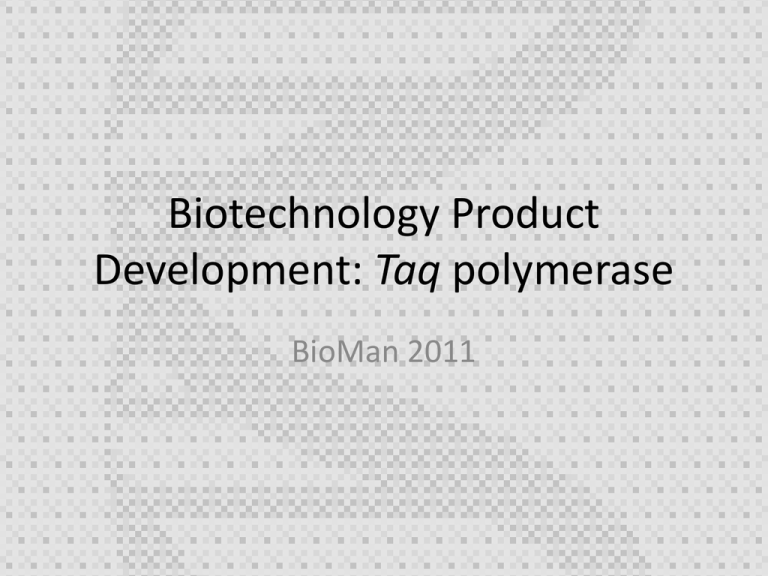
Biotechnology Product Development: Taq polymerase BioMan 2011 Life at High Temperature •High temperatures irreversibly “denature” proteins and nucleic acids. •Postulated that upper limit for life was 730C for some photosynthetic Cyanobacteria (Kemper, 1963). •In 1960’s T.D. Brock started studying hot springs as part of a larger study in microbial ecology (Brock, 1997). •Spring near great fountain geyser, Yellowstone national park. Temp 70 C (158 F) Thermus aquaticus • From Mushroom Spring near Great Fountain Geyser in Yellowstone Park Brock and Freeze isolated T. aquaticus – Image courtesy of David Ward, Montana State University • Thermophiles could also be isolated from hot water heaters, and other “hot” environments. – – http://en.wikipedia.org/wiki/Thermus_aquaticus T. D. Brock and H. Freeze 1969. Thermus aquaticus gen. n. and sp. n., a Nonsporulating Extreme Thermophile J. Bacteriol. 98(1): 289–297. T.D. Brock and K. L. Boylen. 1973. Presence of Thermophilic Bacteria in Laundry and Domestic Hot Water Heaters. Appl. Microbiology. 25 (1): 72-76 R. Pask-Hughes and R.A.D. Williams 1975. Extremely Thermophilic Gram-negative Bacteria from Hot Tap Water. J. Gen. Micro. 88: 321-328 Thermus aquaticus some characteristics • Morphology: rod shaped, nonmotile, pigmented • Gram stain: negative • Metabolism: obligate aerobe / chemoheterotroph • Growth media: Castenholz TYE • Growth Temperature: 70oC • Doubling Time @ 70oC: 50 min. • pH optimum: 7.5-7.8 Brock & Edwards, 1970 Why Taq? • Can recreate in the classroom the discovery research, manufacturing, and commercialization pipeline – Can be adopted to a variety of institutional settings • Can bring in numerous ancillary and related topics: – – – – Intellectual property Bioprospecting Microbial diversity and ecology Biotechnology product development • Can make something that can be used ! How we use T. aquaticus at CCBC? • Incorporated (at different scales) into three different courses: – Intro, molecular, and manufacturing • Teaching topics: – – – – – – – DNA isolation Gene cloning PCR Fermentation Protein expression Protein purification Quality control Thermophiles & extreme thermophiles are of interest from a basic science view and as well as a biotechnological view. Why? Schedule • Day 1: Introduction & Cloning: – Overview of project and how it fits into biomanufacturing training (1:00-1:30, 30 minutes) – Sources of Thermus, growth, and DNA isolation (1:30-2:00, 30 minutes) – DNA isolation (2:00-2:45, 45 minutes) • • • • • Shaking water bath capable of 700C 1- 5 ml liquid culture of T. aquaticus for each participant Water bath or heat block at 370C Microfuge Waterbath or heatblock at 800C – PCR amplification (2:45-3:30, 45 minutes) • • • • Thermocycler Pipettes & Tips Thin wall PCR tubes PCR reagents (dNTP’s, enzyme, buffer, DMSO, water, forward and reverse primers) – Wrap-up, questions, teaching strategies (3:30-4:00, 30 minutes) Schedule • • • Day 2: Quality Control (Note, in order to have time to observe results of QC assays QC section precedes manufacturing) Introduction (1:00-1:10, 10 minutes) SDS-PAGE for identity (1:10-1:55, 45 minutes) – – – – – • PCR activity assay (1:55-2:40, 45 minutes) – – – – • SDS-PAGE system (8% Tris-Glycine Gels) Buffer Coomassie Stain Water bath or oven capable of 700C Destain Thermocycler Pipettes & Tips Thin wall PCR tubes PCR reagents (template, dNTP’s, protein extract, buffer, water, forward and reverse primers) Quality control in the manufacturing environment (2:40-3:10, 30 minutes) – Attributes of quality – Identity assays, potency (activity assays) • Stain/destain SDS-PAGE gel (3:10-3:30, 30 minutes-destain overnight) – Commassie solution – Microwave oven • Wrap up, questions, teaching strategies (3:30-4:00, 30 minutes) Schedule • Day 3: Manufacturing – Protein expression with the pET system and alternatives (1:00-1:30, 30 minutes) • Shaker flask vs. bioreactor growth • Purification strategies • Cell harvest and purification 2:15-3:30, 1 hour 15 minutes) • Microfuge • Heat block capable of 800C • Wrap up, questions, teaching strategies (3:304:00, 30 minutes) Sources of Thermus sp. • ATCC http://www.atcc.org – Strain YT-1 (ATCC # 25104) is source of Taq used in Cetus patents. – According to Brock, several isolates were screened for activity by Cetus but YT-1 proved most suitable and served as source for cloning. • Hot water sources – Reported by Brock and Freeze, Brock and Boylen, and later by PaskHughes and Williams that Thermus sp. Could be isolated from hot tap water and hot water heaters. – We are currently trying this with some micro students at CCBC Cultivation of T. aquaticus • Easiest are liquid cultures with Castenholtz TYE media: – We prepare it – Aged media? – Heavy innoculum from -700 • Solid media (Castenholtz TYE) – More difficult due to drying/condensation on plates – Hybridization ovens/platform above hot water bath – Higher concentration of agar • Other media (Averhoff, 2006) DNA Isolation • Wizard Preps (Promega) or Phenol/CHCl3 extraction both work well A B C D E F A. B. C. D. E. F. 1 Kb ladder 100 bp ladder Wizard Prep (3 mls cells) Homemade prep (3 mls cells) Homemade prep + RNase Homemade prep - RNase DNA Isolation • Covered extensively in molecular class – Focus is on basic steps (cell lysis, nuclease inactivation, organic extraction, alcohol precipitation – and what each chemical component (Tris, EDTA, CTAB, NaCl, phenol/CHCl3, Et-OH, RNase, membrane’s etc) does. – Good animations and teaching aids at: http://www.promega.com/resources/teaching-andtraining/4-genomic-dna-purification/ DNA Isolation • Lecture 1: Principals of DNA/RNA Isolation (Part 1-General Principals of DNA isolation ) • -Describe the general principals of DNA isolation • -Describe the function of chemicals , solutions and techniques such as organic extraction and ethanol precipitation. • -Differentiate between solution and membrane based methods. • -Be able to describe considerations for specific sources (i.e. soli, bacteria, yeast, animal cells). • Lecture 2: Principals of DNA/RNA Isolation (Part 2- Considerations in plasmid DNA, genomic DNA, chromosomal DNA, and RNA isolation) • -Describe differences in the isolation of genomic DNA, plasmid DNA, intact chromosomes, total RNA and mRNA • -Be able to describe differences between RNA and DNA isolation protocols • -Be able to describe what RNase is and how to avoid contamination. • PCR • A main focus in our molecular course: – What it does, how it can be used, resources • Goal is that given a particular gene sequence students should be able to design a PCR strategy to clone that particular gene • Primer design • Reaction components • Reaction conditions PCR • • • • Lecture 9: The Polymerase Chain Reaction Part 1: Objectives: -Be able to describe the components of a typical PCR reaction including reaction concentrations -Be able to calculate the volumes of stock reagents necessary for setting up a PCR reaction -Be able to describe appropriate controls used in PCR Lecture 11: The Polymerase Chain Reaction Part II: Factors that affect primer design - Primer design programs -Be able to describe criteria for selecting and designing primers for PCR experiments -Correctly calculate the concentration of primers present when reconstituted -Be able to describe different methods for calculating Tm and affects on PCR program -Be able to use software such as Primer 3 to design appropriate PCR primers -Describe the rational for hot start and touchdown PCR Lecture 13: The Polymerase Chain Reaction Part III: Troubleshooting -Be able to describe common trouble shooting techniques in PCR -Be able to describe the proper use of controls in PCR reactions -Be able to describe and assemble a master mix for PCR -Be able to describe how altering Mg concentration can affect PCR -Be able to describe how DMSO and other enhancing agents are used in PCR Lecture 14: The Polymerase Chain Reaction Part IV: Real Time PCR -Be able to describe how RT-PCR can be used to quantify mRNA levels. -Be able to describe alternatives to RT-PCR. -Be able to compare and contrast RT-PCR quantification methods -Be able to describe the use of controls and references in RT-PCR PCR assignment • Clone Taq polymerase gene into vector pET17b – Find sequence in Genebank – Design primers (Primer 3, manual) – Do PCR – Isolate fragment (Qiaquick™ extraction) • cut, purify, ligate, transform – Analyze clones • Colony PCR, plasmid mini-preps, restriction map – Express protein Primer design Start students off with basics of primer design, i.e. location, length, Tm, base composition, etc. Then introduce web based tools for primer design. PCR • Primers: – fwd • GGAATTCCATATGCTGCCCCTCTTTGAGCCCAAG • Eco RI & Nde I sites (not underlined) – Rev • GGAATTCTATCACTCCTTGGCGGAGAGCCAGTC • Eco RI site (not underlined) Enzymes • Initially used enzyme Pfu from New England Biolabs – higher fidelity, processivity, and temperature stability then Taq – For class use we now use homegrown Taq and use the original pET-Taq clone (4A4) for protein expression. Vector- pET-17b pET vectors developed at Brookhaven national laboratory based on phage T7 gene 10 promoter. T7 RNA polymerase induced by IPTG Requires expression in BL21 (DE3) cells which contain a T7 lysogen Initial cloning done in JM109 cells then plasmids transferred to BL-21 (DE3) for expression PlasmaDNA software – available free from:http://research.med.helsinki.fi/plasmadna/ Good program to get students familiar with in silico cloning, PCR, ligations, etc. pET-Taq pET-17b vector PCR Template (0.6 µg/ µl ) Fwd Primer (648 µM) Rev Primer (893 µM) Buffer (5X) dNTP’s (10 mM) DMSO (100%) Enzyme (Pfu) H2O T.V. Taq-2 step PCR rxn 1. 980 C (30 sec) 2. 980 C (15 sec) 3. 720 C (1 min) 4. Go to step 2- 29 times 5. 720 C (5 min) 6. 40 C (forever) 2.5 µl 12.0 µl (1:100) 12.1 µl (1:100) 10.0 µl 1.0 µl 2.5 µl 0.5 µl 9.4 µl 50.0 µl Cloning • Isolate fragment with Qiagen Qiaquick gel extraction kit (membrane based method) – See Handout • Digest with Nde I and EcoI RI – (or other suitable enzymes) • Electrophoresis or PCR cleanup – We use electrophoresis and Qiaquick method again • Ligate into Nde I / Eco RI digested pET-17b • Transform – Now use homemade cells – no need for heat shock & cheaper – student prepared Cloning • Analysis of clones – Colony PCR (most common problem is too much template) • Pick colony-patch small amount (1/4 inch) on plate, remainder suspended in 50 µl H2O-use 5 µl for template (may have to dilute) – Mini-Prep • Have used both home-made STET preps (boiling miniprep) and kits (Qiaquick again!) • Equivalent yields but Qiaquick is faster pET-Taq 1. 2. 3. 4. T7 gene 10 promoter Ampicillin resistance ColE1 origin of replication No T7 “tag” due to use of Nde I site. 5. BL21 (DE3) pLysS strain of E. coli for expression 6. IPTG inducible PlasmaDNA program : http://research.med.helsinki.fi/plasmadna/ PlasmaDNA: a free, cross-platform plasmid manipulation program for molecular biology laboratories BMC Molecular Biology 2007, 8:77 Small scale expression • Finish up molecular course with small scale expression, extraction and activity assay (see hand out) – Introduces protein techniques – Discuss tech-transfer (transfer of R&D products to production) • • • • • Scale-Up Specifications Quality assays SOP’s Master Cell Bank characterization (ICH guidelines) Small scale expression • Induction at 300 C / R.T. increases yield of soluble active enzyme – Inclusion body formation: • Possible to purify enzyme from inclusion bodies but we have not tried-typically not suitable for large scale – Similar effect seem with GFP expression using pET Small scale expression • Grow cells at 370 C till O.D. ~1.0 – Equilibrate cells at 300 C and add IPTG to 0.4 mM – Let grow several hours to overnight – Harvest! Small scale purification • Harvest by centrifugation in microfuge – 16,000 x g for 1 minute • Cells lysed in Tris, Glucose, EDTA + lysozyme • KCl, Tween-20, & Nonidet P-40 (sigma substitute) added and extract heated to 800 C for 30 minutes • Insoluble fraction centrifuged out at 16,000 x g for 10 minutes • Soluble fraction stored in NaCl, DTT, Triton X100, and glycerol Quality Control • Basic quality control introduced in molecular class – Identity by SDS-PAGE – Contaminants by SDS-PAGE – Activity by PCR assay Next Gen PCR products • By this time students should be familiar with basic properties of Taq and PCR – Good and Bad ! • What improvements could be made? Taq polymerase • Two versions available – Full length protein & Stoffel fragment (544 Cterminal residues of Taq) – Full length enzyme: • • • • • • • 75-800 optimum temp. 5’-3’ exonuclease activity Terminal transferase activity Low fidelity (no proofreading activity) Stability is ~9 min. at 97.50C Km dNTP = 10-16 µM Kcat = 60-150 Taq Stoffel fragment (544 C-terminal a.a.) • Increased stability at elevated temp, but decreased processivity (ability to amplify long targets (amplicons)). – – – – Stability ~ 21 min at 97.5 0C No exonuclease activity Terminal transferase activity Lower processivity then full length version Error Rates for Taq (Thermus aquaticus) enzyme • • • • • • • 1.1 x 10-4 base substitutions/bp (Tindall and Kunkel, 1988) 2.4 x 10-5 frameshift mutations/bp (Tindall and Kunkel, 1988) 2.1 x 10-4 errors/bp (Keohavang and Thilly, 1989) 7.2 x 10-5 errors/bp (Ling et al., 1991) 8.9 x 10-5 errors/bp (Cariello et al., 1991) 2.0 x 10-5 errors/bp (Lundberg et al., 1991) 1.1 x 10-4 errors/bp (Barnes, 1992) • http://wheat.pw.usda.gov/~lazo/methods/101/taq-errors.html Error Rates of other thermostable polymerases • KlenTaq (Thermus aquaticus, N-terminal deletion mutant-Stoffel fragment) – 5.1 x 10-5 errors/bp (Barnes, 1992) • Vent (Thermococcus litoralis) – 2.4 x 10-5 errors/bp (Cariello et al., 1991) – 4.5 x 10-5 errors/bp (Ling et al., 1991) – 5.7 x 10-5 errors/bp (Matilla et al., 1991) • Vent(exo-) (Thermococcus litoralis) • 1.9 x 10-4 errors/bp (Matilla et al., 1991) • Deep Vent (Pyrococcus species GB-D) • No published literature. New England Biolabs claims fidelity is equal to or greater than that of Vent. • Deep Vent(exo-) No published literature. • Pfu (Pyrococcus furiosus) • 1.6 x 10-6 errors/base (Lundberg et al., 1991) • Replinase (Thermus flavis) • 8. 1.03 x 10-4 errors/base (Matilla et al., 1991) Manufacturing Reproducible production of product that meets predetermined specifications – What are the specifications for final product • • • • Appearance – color, clarity Chemical characteristics- pH, SDS-PAGE, UV absorbance Activity – qualitative, quantitative * Contaminants – DNA, RNA, endo and exo nucleases, endotoxin cGMP’s Manufacturing course focuses on producing therapeutic proteins in a regulated environment cGMP requirements 21 CFR part 210 and 211 Documentation • Foundation of cGMP’s ! – SOP’s – Batch Records – Quality control assays – Label Process Development • Robust, scalable processes – Goal is to take what we have learned at small scale and apply it to large scale (economics) production – Upstream (i.e. fermentation & expression) – Downstream (i.e. purification) Scale-Up • Yield from small scale culture – – 2 ml/LB+Amp+Cm / 300 C / 20 hr induction ~ 2,000 units / ml of culture (should have mg/protein) Q. What can we get from 2,000 ml culture ? A. 4,000,000 units ? More? Upstream Scale Up Shaker Flask Bench Top Fermentor Pilot Scale Fermentor Production scale Fermentor Upstream Goal-Maximum cell density – Physical conditions • Temperature control • pH control • O2 availability – Media • Simple / complex / antibiotics / cost! – Feeding strategies • Batch, Fed Batch, continuous – Plasmid stability • antibiotic resistance markers Upstream Goal-Maximum active protein expression • Alternative Promoters & RBS • Active vs. inactive protein • Strain improvement Downstream Scale Up Downstream Goal-Maximum product recovery Use of scalable technologies – filtration, chromatography Purification • Loss during purification – Can purification be scaled-up while reducing loss? • Chromatography & TFF – Size of protein (92Kd) may make possible use of size exclusion chromatography to eliminate smaller contaminants • DNase treatment – Is contamination with bacterial DNA a problem? Stability • Stability studies are a fundamental concept in drug development – We haven’t done these with Taq, but plan on doing so. • Home grown Taq is good for several months when stored at -20 • Once have quantitative assay down we will see if we can quantify stability References Literature: 1. 2. 3. 4. 5. 6. 7. 8. 9. 10. Averhoff, B. 2006. Genetic Systems for Thermus. Methods in Microbiology Vol. 35. p279 Brock, T.D. 1997. The value of Basic Research: Discovery of Thermus aquaticus and Other Extreme Thermophiles. Genetics. 146: 1207-1210. Brock, T.D. and Freeze, H. 1969. Thermus aquaticus gen. n. and sp. n., a Nonsporulating Extreme Thermophile J. Bacteriol. 98(1): 289–297. Brock, T.D. and Edwards, M.R. 1970. Fine Structure of Thermus aquaticus, an Extreme Thermophile. J. Bacteriol. 104 (1) 509-517. Brock, T.D. and Boylen, K.L. 1973. Presence of Thermophilic Bacteria in Laundry and Domestic Hot-Water Heaters. Appl. Microbiol. 25 (1) 72-76. Chien, A, Edgar, D.B., Trela, J.M. 1976. Deoxyribonucleic Acid Polymerase from the Extreme Thermophile Thermus aquaticus. J. Bacteriol. 127 (3) 1550. Ferralli, P., Egan, J.D., Erickson, F.L. 2007. Making Taq DNA polymerase in the undergraduate biology laboratory. Bios 78 (2) 69-74. Fore, J., Wiechers, I.R., Cook-Deegan, R. 2006. The effects of business practices, licensing, and intellectual propoerty on development and dissemination of the polymerase chain reaction: case study. J. Biomedical Discovery and Collaboration. 1(7) This article is available from: http://www.j-biomed-discovery.com/content/1/1/7 Kempner, E., 1963. Upper temperature limit of life. Science 142:1318-1319. Lawyer, F.C., Stoffel, S. Sak, R. K. , Myambo, K., Drummond, R., Gelfand, D.H. 1989. Isolation, Chracterization, and Expression in Esherichia coli of the DNA polymerase gene from Thermus aquaticus . J. Biol. Chem. 264 (11) 6427. Web Resources: • • • • Genebank accession number for sequence J03469 PlasmDNA software Primer 3 – primer design software Novagen pET-vector manual



